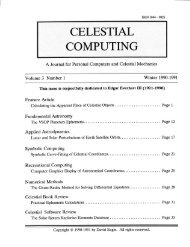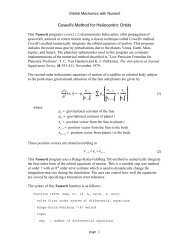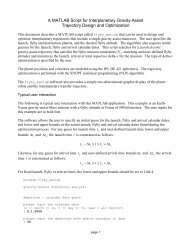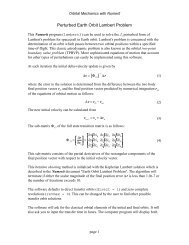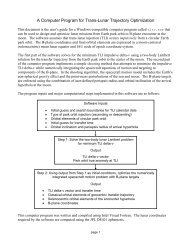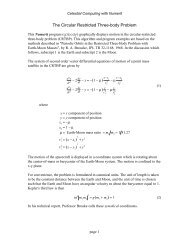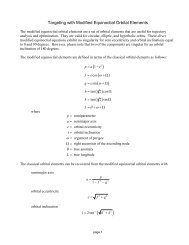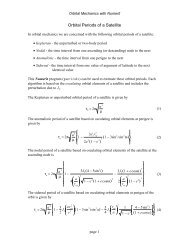Orbital Maneuvers - Orbital and Celestial Mechanics Website
Orbital Maneuvers - Orbital and Celestial Mechanics Website
Orbital Maneuvers - Orbital and Celestial Mechanics Website
You also want an ePaper? Increase the reach of your titles
YUMPU automatically turns print PDFs into web optimized ePapers that Google loves.
Velocity (m/s)<br />
8000<br />
7000<br />
6000<br />
5000<br />
4000<br />
<strong>Orbital</strong> <strong>Mechanics</strong> with MATLAB<br />
Low−thrust Orbit Transfer<br />
3000<br />
0 20 40 60 80 100 120 140 160 180 200<br />
Semimajor Axis (kilometers)<br />
x 104<br />
5<br />
4<br />
3<br />
2<br />
1<br />
0<br />
0 20 40 60 80 100 120 140 160 180 200<br />
Simulation Time (days)<br />
sep_ltot.m – low-thrust orbit transfer using solar-electric propulsion<br />
This interactive MATLAB script can be used to determine the characteristics of continuous, lowthrust<br />
orbital transfer between two non-coplanar circular orbits using solar-electric propulsion<br />
(SEP). The numerical method used in this script is identical to the technique used in the ltot.m<br />
script described previously.<br />
The propulsive thrust provided by an SEP system is given by<br />
2<br />
P<br />
T <br />
gI<br />
where is the non-dimensional propulsive efficiency, P is the input power in kilowatts, g is the<br />
acceleration of gravity in meters/second <strong>and</strong> I sp is the specific impulse in seconds. The quantity<br />
gI sp is also called the exhaust velocity. Note that with these metric units the thrust will be in<br />
milli-newtons. The thrust acceleration required in the equations to follow is equal to aT T m<br />
where m is the mass of the spacecraft.<br />
This MATLAB script will prompt you for the initial <strong>and</strong> final altitudes <strong>and</strong> orbital inclinations,<br />
<strong>and</strong> the SEP propulsive characteristics. The following is a typical user interaction with this<br />
script. It illustrates an orbital transfer from a low Earth orbit (LEO) with an inclination of 28.5<br />
to a geosynchronous Earth orbit (GSO) with an orbital inclination of 0.<br />
sp<br />
page 16




